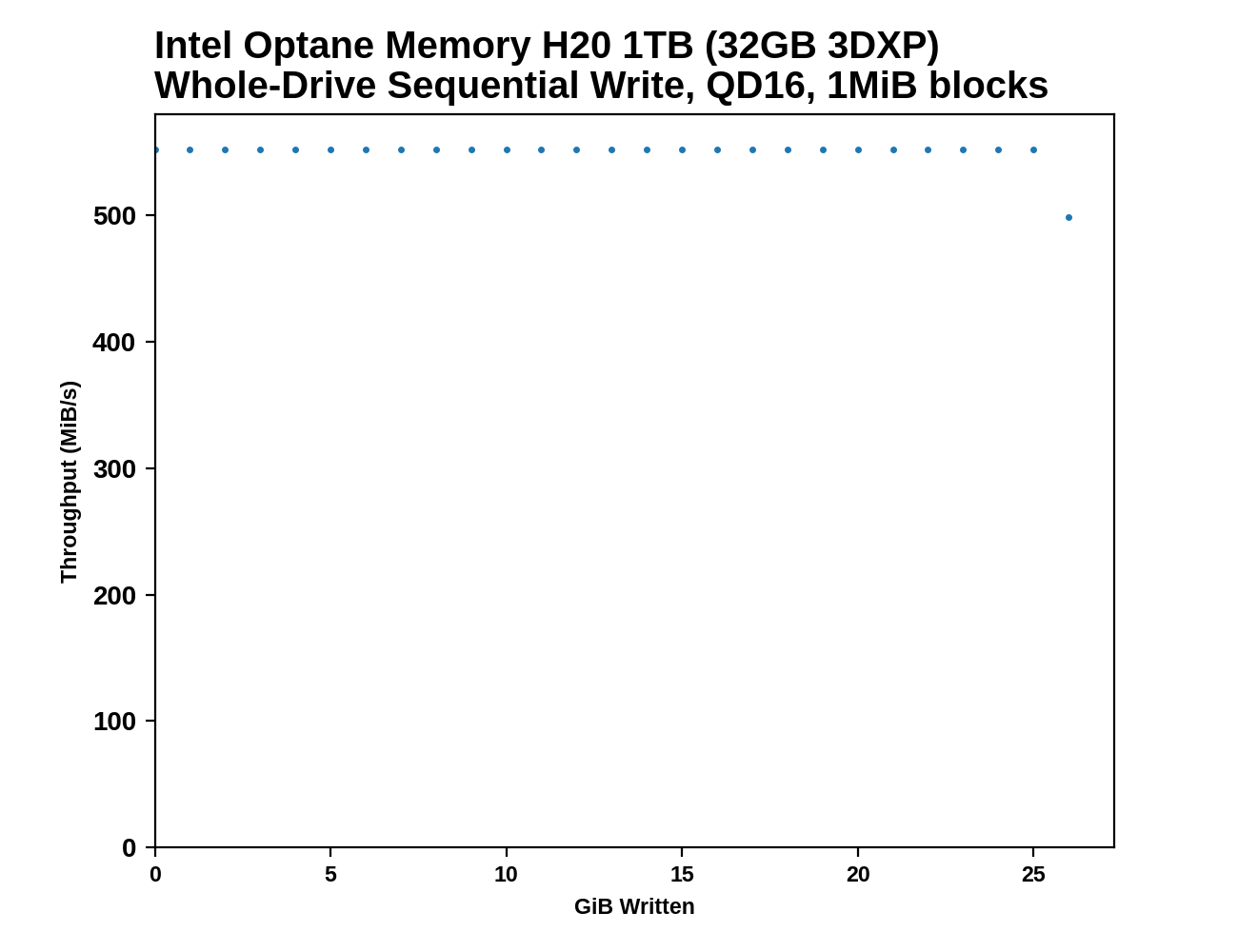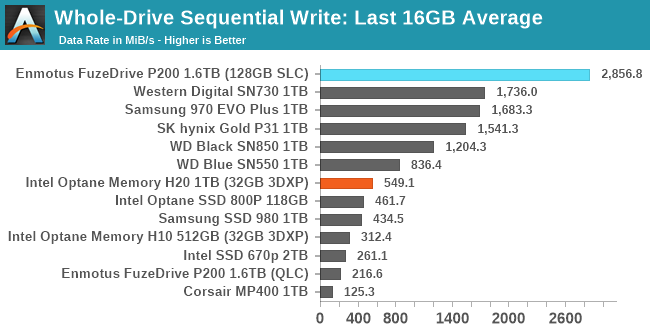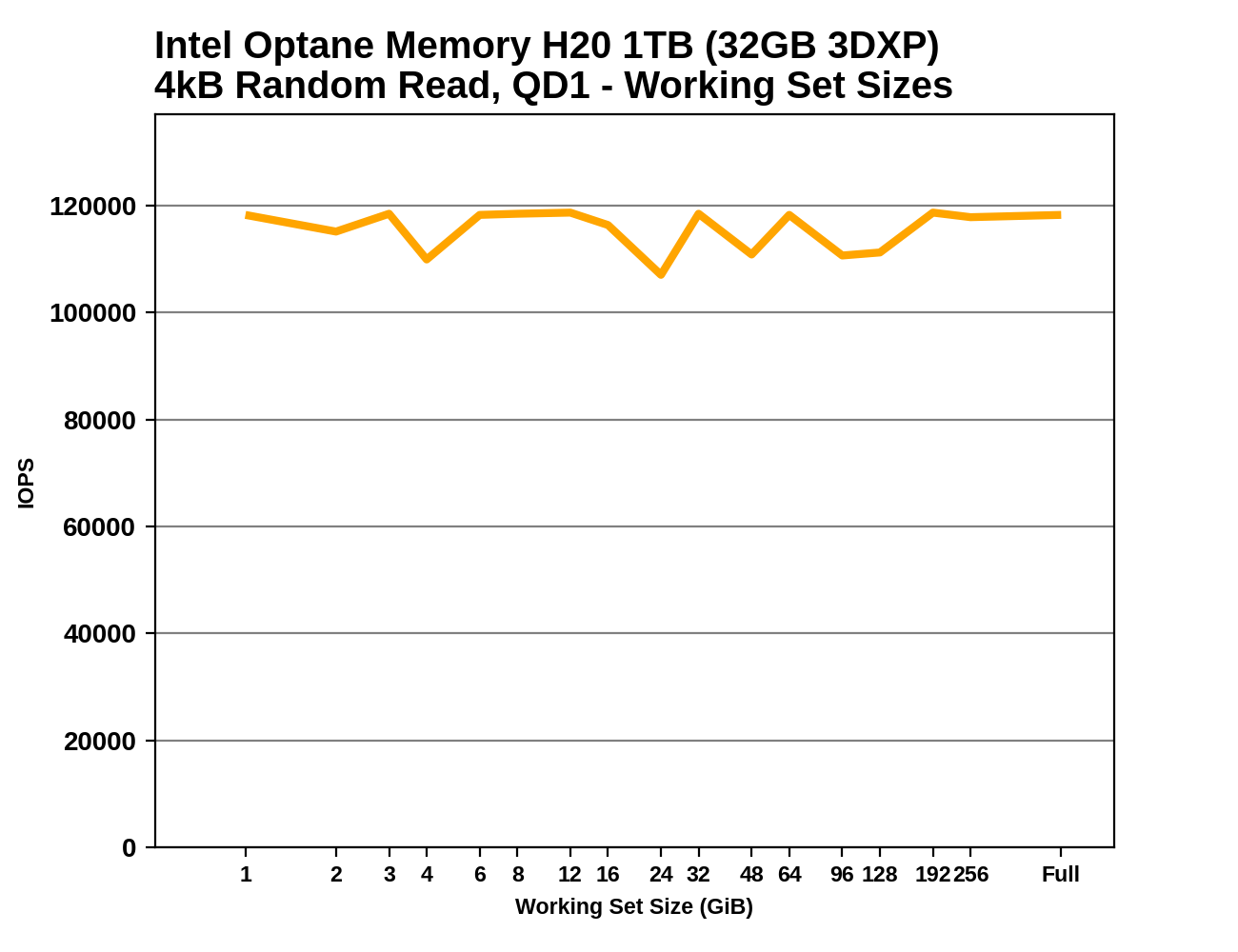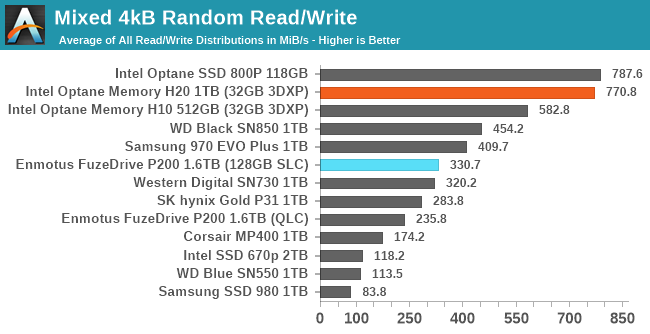Caching And Tiering: Intel Optane Memory H20 and Enmotus FuzeDrive SSD Reviewed
by Billy Tallis on May 18, 2021 2:00 PM EST- Posted in
- SSDs
- Storage
- Intel
- SSD Caching
- 3D XPoint
- Optane
- Optane Memory
- Tiger Lake
Our suite of Linux-based synthetic tests cannot directly measure how the Intel Optane Memory H20 or Enmotus FuzeDrive SSD behave when used with their respective caching or tiering software, but we can investigate how the individual components of those storage systems perform in isolation. The tests on this page are all conducted on our usual AMD Ryzen testbed.
Advanced Synthetic Tests
Our benchmark suite includes a variety of tests that are less about replicating any real-world IO patterns, and more about exposing the inner workings of a drive with narrowly-focused tests. Many of these tests will show exaggerated differences between drives, and for the most part that should not be taken as a sign that one drive will be drastically faster for real-world usage. These tests are about satisfying curiosity, and are not good measures of overall drive performance. For more details, please see the overview of our 2021 Consumer SSD Benchmark Suite.
Whole-Drive Fill
 |
|||||||||
| Pass 1 | |||||||||
| Pass 2 | |||||||||
As expected, we see fairly steady write performance from the Intel Optane devices, including on the second write pass—but the total throughput is still quite low compared to NAND SSDs. The SLC portion of the Enmotus FuzeDrive SSD has similar performance consistency, but competitive throughput. The QLC portion of that drive does have the typical drive-managed SLC cache that starts out with a capacity of about 333 GB when this section of the drive is empty, and shrinks down to about 19 GB for the second pass when the drive is full.
 |
|||||||||
| Average Throughput for last 16 GB | Overall Average Throughput | ||||||||
The SLC portion of the Enmotus FuzeDrive SSD is naturally far faster for the overall fill process than the drives that run out of SLC and slow down part way through. The Optane devices aren't quite in a "slow and steady wins the race" situation against the traditional NAND SSDs, but the Optane Memory H20's cache device is at least faster than the post-cache performance of the QLC drives and the DRAMless Samsung 980.
Working Set Size
 |
|||||||||
There's a bit of variability in the random read latency of the Optane cache on the Optane Memory H20, but it's so much faster than the NAND devices that a bit of inconsistency hardly matters. We're just seeing noise that only shows up at this scale and is insignificant at NAND speeds. The SLC slice of the FuzeDrive SSD is faster than any of the other NAND drives, but it's a narrow lead. These fast devices naturally do not show any of the performance drop-off that comes from having insufficient DRAM: the Optane caches don't need it in the first place, and the SLC portion of the FuzeDrive SSD is small enough to be managed with a fraction of the drive's DRAM.
Performance vs Block Size
 |
|||||||||
| Random Read | |||||||||
| Random Write | |||||||||
| Sequential Read | |||||||||
| Sequential Write | |||||||||
The Optane cache on the H20 behaves almost exactly like previous Optane Memory devices, except that it has acquired a strong dislike for sequential writes one 512B sector at a time. We often see sub-4kB sequential writes performing badly on NAND devices because the flash translation layer operates with 4kB granularity, so perhaps Intel has switched something in this Optane module to operate with 1kB granularity and it now needs to perform a read-modify-write cycle to handle this case. (The lack of a similar performance drop for random writes is a bit of a puzzle.)
The SLC portion of the Enmotus FuzeDrive SSD shows similar overall behavior to other Phison-based NAND drives, albeit with generally higher performance.
Mixed IO Performance
For details on our mixed IO tests, please see the overview of our 2021 Consumer SSD Benchmark Suite.
 |
|||||||||
| Mixed Random IO | Throughput | Power | Efficiency | ||||||
| Mixed Sequential IO | Throughput | Power | Efficiency | ||||||
The Intel Optane devices handle the mixed random IO test better than any of the NAND drives, and the Optane Memory H20's speed improvements over the H10 bring it up to the level of the larger 118GB Optane SSD 800P. The SLC portion of the Enmotus FuzeDrive SSD performs comparably to a decent 1TB TLC drive with SLC cache.
On the mixed sequential IO test, the Optane devices are far slower than the NAND devices, and the SLC has no real advantage either. A fast controller and lots of NAND is the best recipe for high performance on this test.
 |
|||||||||
| Mixed Random IO | |||||||||
| Mixed Sequential IO | |||||||||
The Optane devices show completely different performance trends from the NAND devices on the mixed random IO test: the Optane drives speed up significantly as the workload gets more write-heavy, while the NAND drives have flat or declining performance. On the mixed sequential IO test, the Optane behavior is a bit more normal, albeit with very low-end performance.










45 Comments
View All Comments
powerarmour - Tuesday, May 18, 2021 - link
QLC garbage again, I can hardly contain myself.Samus - Wednesday, May 19, 2021 - link
Understanding QLC's place in the market (cheap bulk flash storage) I'm also struggling to understand who these premium-priced QLC products are for. Seriously who is going to pay 23-25¢/GB for something like this when it's only crutch is high read throughput that has zero real world advantage for virtually all PC users.Wereweeb - Wednesday, May 19, 2021 - link
These products are both proofs of concept, and an advertising for the importance of Caching/Tiering.Enmotus managed to get 3600 TBW out of a 2TB QLC SSD by reducing it's available capacity by a bit and using their software.
philehidiot - Wednesday, May 19, 2021 - link
There is definitely the endurance advantage, but you don't need a commercial product for proof of concept. Indeed, I'd say releasing a commercial product just to prove it can be done where there is no real use for it is a bit daft. Unless they plan to inflict it upon customers in a data collection exercise, using their muscle to force it into laptops. We have already seen the advantages of this kind of tech when smaller SSDs were placed as a cache / tier into HDDs.If their plan is to build this into an industrial product, their proof of concept should be a bunch of engineering samples tested for endurance, not a bodged consumer grade product which seems as though it's going to do more to show you can have a very complex and bodged product and it just about compete with what's already established on the market.
As for advertising, I'd say this is a pretty poor advert. Someone mentioned that Intel's storage division has been held back and it strikes me this is the case. This isn't a new and exciting product, it's two technologies being put together with an inadequate hardware interface and terrible software.
It has potential, but the people who will accept QLC NAND won't know or care what this is and the people who might benefit from the high DWPD won't touch it with a barge pole.
This should have stayed in R&D until it could add something to the market.
Samus - Thursday, May 20, 2021 - link
I'll believe it when it's independently tested. No level of software trickery will enable massive gains in TBW. If you fully write to a drive, the physical cells are fully utilized. Sure you can mask this with a large spare area and aggressive wear leveling but even a 2TB QLD SSD with 4TB of physical NAND (so 2TB spare area) will only yield 4x the endurance and that's best case scenario.Enmotus can't break the laws of physics with intelligent software unless they've come up with some revolutionary hardware deduplication\compression algorithm that is limiting physical changes to NAND by many orders of magnitude, while also eliminating write amplification that is essential to modern ECC for data integrity.
Billy Tallis - Thursday, May 20, 2021 - link
The key advantage the Enmotus drive has over regular QLC drives is that the static SLC portion can be used for far more P/E cycles. On a regular QLC drive, which blocks are used for the dynamic SLC cache is constantly changing, and the fact that a block that's currently operating as SLC may soon be repurposed as QLC effectively prevents it from being rated for more P/E cycles than QLC usage can permit. But with a large pool of permanent SLC, the drive can safely re-use those cells long past the point where they would be unusable as QLC. 128GiB at 30k P/E cycles can on its own handle more total writes than the drive as a whole is rated for.As long as the tiering software does a good job of preventing most writes and write amplification from ever getting to the QLC part of the drive, the endurance rating is completely realistic. The tiering software won't be able to keep the wear confined to the SLC if you are using the drive as a giant circular buffer for video recording or something else that keeps the drive full and constantly modifies all of the data. But most real consumer workloads have a small amount of hot data that's frequently changing and a large amount of cold data that doesn't get rewritten often enough to pose a problem for QLC.
Spunjji - Wednesday, May 19, 2021 - link
Agreed - this would really need to show a serious performance benefit at a similar cost to a TLC drive, or lower cost and similar performance. As it is, it does neither. I'm sure OEMs will lap it up at whatever knockdown price Intel offers it to them to clear the shelves.Spunjji - Wednesday, May 19, 2021 - link
Derped there and confused the price of the Enmotus with the H20... the Enmotus product really does seem to be in a bad place for price vs. consumer appeal without the benefit of Intel's cosy relationship with OEMs.Morawka - Friday, May 21, 2021 - link
The Enmotus product is perfect for Chia miners. Plotting on Chia absolutely destroys consumer-grade SSD's. A 980 Pro will get smoked in around 3 months, whereas this Enmotus drive, even though it's pricier, will last 3-5x longer.Billy Tallis - Friday, May 21, 2021 - link
I think Chia plotting requires more space than the SLC portion of the Enmotus drive, and plotting is an example of the kinds of workloads that would not be handled well by the Enmotus tiering software unless the plotting could fit entirely in the SLC tier.